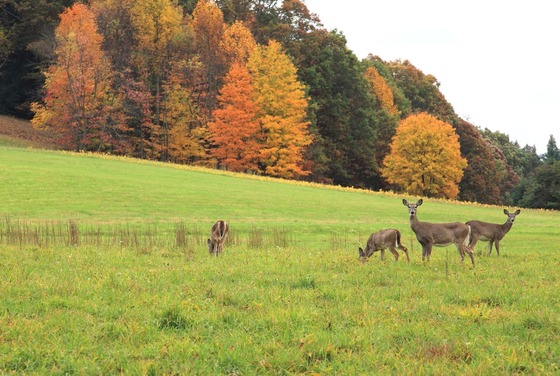|
FOR IMMEDIATE RELEASE: Sept. 12, 2024
Contact: Erin Larson, DNR Deer Herd Health Specialist
[email protected] or 608-516-2783
Help Maintain A Healthy Herd: Avoid Baiting
And Feeding Deer
 Baiting and feeding encourage deer to congregate unnaturally around a specific location, creating an environment where infected deer can quickly spread CWD. / Photo Credit: iStock/mountainberryphoto
MADISON, Wis. – The Wisconsin Department of Natural Resources (DNR) reminds hunters and the public to help prevent the spread of chronic wasting disease (CWD) and other illnesses between deer by following all baiting and feeding bans and refraining from baiting and feeding in areas where no bans are in effect.
CWD is an always-fatal disease that affects the nervous system of deer, elk, moose and caribou caused by a misshapen prion protein. The disease can spread through contact with an infected animal's saliva, urine, feces or blood. It can also spread indirectly through exposure to a contaminated environment. CWD prions are extremely resilient, and they can stay in the soil for a long time, making containment of an affected area a challenge.
Baiting is the intentional placement of any material, including food, scented materials, salts, minerals and grains, to attract wild animals for hunting purposes. Feeding is the deliberate placement of material used to feed or attract wild animals for non-hunting purposes, including recreational and supplemental feeding, except as allowed for birds and small mammals.
Baiting and feeding encourage deer to congregate unnaturally around a specific location, creating an environment where infected deer can quickly spread diseases like CWD through direct contact with healthy deer or through indirect contact in the environment.
Infected deer can also leave infectious CWD prions behind in their saliva, blood, feces and urine, creating a risk to any healthy deer that may visit the site in the future. CWD can spread rapidly when these prions remain in an area where more deer are sure to congregate, such as a feed pile.
To mitigate these risks and slow the spread of CWD, state law directs the DNR to impose baiting and feeding bans within any county with a confirmed CWD-positive wild or captive deer or any county within 10 miles of the location of the positive deer.
Counties fall under a three-year baiting and feeding ban when a wild or farm-raised deer tests positive for CWD in the county. If the CWD-positive deer is found within 10 miles of a county line, the adjoining county will fall under a two-year ban. If additional CWD cases are found during the lifetime of a baiting and feeding ban, the ban will reset for an additional two to three years. Therefore, the date when a baiting and feeding ban would be lifted on a given county may change due to new farm-raised and wild CWD positive detections.
In counties where baiting and feeding bans are in effect, individuals may still feed birds and small mammals provided feeding devices are within 50 yards of a human dwelling and at a sufficient height or design to prevent access by deer.
Find more information on baiting and feeding regulations and a map of counties with active bans on the DNR’s Baiting and Feeding Regulations webpage.
|
